RESEARCH/REVIEW ARTICLE
A surge of the glaciers Skobreen–Paulabreen, Svalbard, observed by time-lapse photographs and remote sensing data
Lene Kristensen1 & Douglas I. Benn1,2
1 Department of Arctic Geology, The University Centre in Svalbard, NO-9171 Longyearbyen, Norway
2 School of Geography and Geosciences, Irvine Building, University of St Andrews, North Street, KY16 9AL Fife, UK
Abstract
We present observations of a surge of the glaciers Skobreen–Paulabreen, Svalbard, during 2003–05, including a time-lapse movie of the frontal advance during 2005, Advanced Spaceborne Thermal Emission (ASTER) imagery and oblique aerial photographs. The surge initiated in Skobreen, and then propagated downglacier into the lower parts of Paulabreen. ASTER satellite images from different stages of the surge are used to evaluate the surge progression. Features on the glacier surface advanced 2800 m over 2.4 yr, averaging 3.2 m/day, while the front advanced less (ca. 1300 m) due to contemporaneous calving. The surge resulted in a lateral displacement of the medial moraines of Paulabreen of ca. 600 m at the glacier front. The time-lapse movie captured the advance of the frontal part of the glacier, and dramatically illustrates glacier dynamic processes in an accessible way. The movie documents a range of processes such as a plug-like flow of the glacier, proglacial thrusting, incorporation of old, dead ice at the margin, and calving into the fjord. The movie provides a useful resource for researchers, educators seeking to teach and inspire students, and those wishing to communicate the fascination of glacier science to a wider public.
Keywords
Glacier surge; time-lapse movie; Skobreen; Paulabreen; Svalbard.
Correspondence
Douglas I. Benn, Department of Arctic Geology, The University Centre in Svalbard, PO Box 156, NO-9171 Longyearbyen, Norway. E-mail: doug.benn@unis.no
To access the supplementary material to this article please see
Supplementary Files under Article Tools online.
(Published: 12 November 2012)
Polar Research 2012. © 2012 L. Kristensen & D.I. Benn. This is an open-access article distributed under the terms of the Creative Commons Attribution-Noncommercial 3.0 Unported License (http://creativecommons.org/licenses/by-nc/3.0/), permitting all non-commercial use, distribution, and reproduction in any medium, provided the original work is properly cited.
Citation: Polar Research 2012, 31, 11106, http://dx.doi.org/10.3402/polar.v31i0.11106
Surges are among the most dramatic of all glacial phenomena. When a glacier surges, ice velocities can increase by one or two orders of magnitude, drawing down ice from reservoir areas towards the front, in some cases producing ice-front advances of several kilometres. These radical transformations reflect switches in the thermal and/or hydrological conditions at the glacier bed, resulting from some combination of internal dynamic processes and external environmental conditions (e.g., Kamb et al. 1985; Eisen et al. 2001; Fowler et al. 2001; Hewitt 2007). The classic definition of surging glaciers emphasizes quasi-periodic velocity fluctuations, in which glaciers cycle between periods of rapid motion lasting a few months to several years—the surge or active stage—and periods of slow flow lasting several years to decades—quiescent periods (Meier & Post 1969; Dowdeswell et al. 1995). Other glaciers have been observed to surge only once, and it may be unclear whether the surge was an isolated occurrence or if the surge return period was longer than the period of observation. Few surging glaciers have been studied in detail, although it is clear that they can exhibit a very wide range of behaviour. Surges can be “fast” (with velocities of several kilometres per year) or “slow” (with velocities of a few tens of metres per year); they can affect both temperate and polythermal glaciers, and land-based and calving glaciers (Harrison & Post 2003; Murray et al. 2003; Nolan 2003; Frappe & Clarke 2007).
Surging glaciers are of great interest scientifically, because they can shed light on dynamic instabilities and threshold behaviour in glacier systems. Study of the geomorphological and sedimentological products of surging glaciers can allow glacial geologists to better interpret evidence for past glacier activity and its climatic implications (Evans & Rea 2003; Ottesen et al. 2008). Additionally, surges provide educators with spectacular examples of glacier behaviour, which can capture the interest and imagination of students and lay people alike.
In 2005, Paulabreen, a tidewater-terminating glacier in Svalbard, underwent a rapid advance which was the culmination of a surge that started several years earlier on its tributary glacier, Skobreen (Sund 2006). We were able to record this event using time-lapse photography, using an automatic camera installed near the glacier front. To our knowledge, this movie was the first to capture a surge of a polythermal glacier, providing striking evidence for glaciological and geomorphological processes at the surge front. In this contribution, we make the movie available for download and provide a commentary describing the main features that can be seen as the surge progresses (see Supplementary File). In addition, we include a selection of satellite images and aerial photographs that place the movie in a wider context, and provide a record of glacier evolution during the surge. Taken together, the movie and images provide a resource for the research community and educators, which illustrates the progress of a High-Arctic surge and its impacts on the proglacial environment.
Study area and glaciological background
Svalbard is one of several regions in the world with a high concentration of surge-type glaciers. Estimates of the percentage of Svalbard glaciers that are of this type range from 13% to 90%, depending on the criteria used for inclusion (Hagen et al. 1993; Hamilton & Dowdeswell 1996; Jiskoot et al. 1998). The surge and the quiescent periods are somewhat longer lasting for Svalbard glaciers (40–500 yr for the quiescent period) than for surge-type glaciers in other regions of the world (Dowdeswell et al. 1991; Hagen et al. 1993). For this reason, the number of surge-type glaciers in Svalbard is likely to be underestimated in statistical analyses, which only include observed surges. Nuth et al. (2007) found that most glaciers on Spitsbergen (the largest of Svalbard's islands) had lost mass between 1936/38 and 1990, although many had thickened in their upper parts, possibly reflecting ice build-up during quiescent periods following surges. Recent patterns of mass displacement determined from aerial photographs and satellite imagery indicate that “partial surges” (affecting only the upper parts of glaciers) are common in Svalbard (Sund et al. 2009).
Paulabreen (77° 42’ N, 17° 24’ E) is a tidewater glacier calving into Rindersbukta, inner Van Mijenfjorden (Fig. 1). The glacier is confluent with Bakaninbreen, which last surged (independently of Paulabreen) in 1985–1995 (Murray et al. 2000; Benn et al. 2009). Until recently, Bakaninbreen shared a calving front with Paulabreen, but due to lateral displacement of Bakaninbreen during the 2003–05 surge of Paulabreen, the former now terminates on land. In the early 20th century, Vallåkrabreen, Scheelebreen and Ragna-Mariebreen were major tributaries of Paulabreen, but today they are independent glaciers that terminate on land (Ottesen et al. 2008). Paulabreen, together with all tributaries and Bakaninbreen, covers an area of 141.8 km2 as measured from an Advanced Spaceborne Thermal Emission (ASTER) image from 2005. Taken separately, Paulabreen is 64.6 km2 in area and 16 km long. Skobreen is a tributary of Paulabreen, with an area of 18.2 km2 and a length of 8 km (Hagen et al. 1993). The equilibrium line altitudes (ELAs) of Skobreen and Paulabreen were estimated to be 290 and 330 m a.s.l., respectively by Hagen et al. (1993). Mean annual air temperature is −5.4°C (1997–2006) and precipitation is on average 244 mm/yr (1995–2002) at the coal mine Sveagruva, 18 km north-west of the front of Paulabreen.
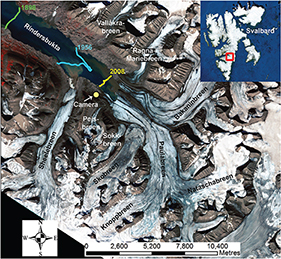
Fig. 1
Overview of the catchment. Two previous glacier-front positions as well as the position reached by the 2003–05 surge are drawn. The position of the RDC365 camera used for the time-lapse movie is shown. Map basis: Advanced Spaceborne Thermal Emission (ASTER) image taken on 24 July 2003.
The bedrock of the Paulabreen catchment consists of shales, siltstones and sandstones of Cretaceous to early Tertiary age. The bedrock weathers and erodes easily and the mountain slopes have large scree aprons covering their lower parts. The geology is important for surge behaviour in Svalbard. Hamilton and Dowdeswell (1996) and Jiskoot et al. (2000) showed that a sedimentary lithology, in particular shale/mudstone as found in this area, significantly increases the probability that a glacier will be of surge type.
Four tributaries of Paulabreen (Skobreen, Sokkbreen, Peisbreen and Ragna-Mariebreen) had arcuate frontal moraines at their confluences with the main glacier before the recent surge (Fig. 1). This contrasts with the tributaries Knoppbreen, Nataschabreen and Bakaninbreen, which form separate flow-units to Paulabreen as indicated by medial moraines starting at the confluences and extending to the glacier front. Aerial photographs from 1936, 1956 and 1990 show that this pattern has persisted since at least 1936.
The Holocene maximum position of Paulabreen is located 25 km from the present glacier front and dates to around 1300 AD (Punning et al. 1976; Rowan et al. 1982; Hald et al. 2001; Kristensen et al. 2009). The moraines record one of the largest Little Ice Age advances (and subsequent retreat) of any Svalbard glacier (De Geer 1919). In 1898, the front was located near the mouth of Rindersbukta (Kjellström 1901) (Fig. 1), then retreated ca. 10 km until 2003. The 2003–05 surge of Paulabreen then caused a frontal advance of 1.9 km (Ottesen et al. 2008). Despite the overall retreat, there is evidence that Scheelebreen, Vallåkrebreen and Ragna-Mariebreen surged and advanced independently around 1919–1925 (De Geer 1919; Cöster 1925). As noted above, Bakaninbreen surged from 1985 to 1995, but the surge terminated before reaching the front and caused no advance. In a series of papers (Porter et al. 1997; Murray et al. 1998; Murray et al. 2000; Fowler et al. 2001; Murray & Porter 2001), it was shown that downglacier propagation of the surge front was associated with thawing of the glacier bed, and that flow acceleration reflected enhanced basal motion over a thin layer of unfrozen basal till.
Methods
Time-lapse movie
A time-lapse camera was placed to the south-west of Paulabreen on 28 April 2005 (Figs. 1, 2). The camera faced east–north-east (067°) with the glacier front near the centre of the image. By early July the front had advanced out of view, and when the camera was visited on 16 August 2005 it was moved ca. 32 m uphill and turned northwards (to 025°) to have the front in view again. The distance to the glacier was ca. 1 km in the beginning but was reduced to ca. 500 m as the glacier advanced.
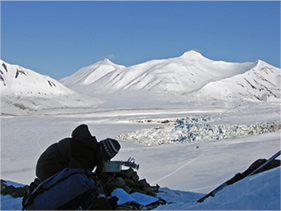
Fig. 2
Placing the time-lapse camera on 28 April 2005. Photographer: Anne-Marie LeBlanc.
The camera was an RDC-365 unit consisting of a CX6200 digital camera (Kodak, Rochester, NY, USA), built into a water-proof box with a time-lapse controller and a solar panel by MetSupport (Roskilde, Denmark). The image resolution is 1632×1232 pixels. The camera was programmed to take one picture per day at 12.00 (local time) with a date-stamp. The RDC365 was mounted on a small bench on the slope overlooking the glacier, on one of the only places free of snow at the time of installation. Later, it was observed that the whole slope was ice-cored and rather unstable, which explains the slight movement of the camera seen in the movie, particularly in the snow melting period.
From the record of the active phase of the surge (29 April 2005 to 15 November 2005), 24 pictures were omitted due to fog, six due to raindrops on the window, 14 due to snow on the window and five due to the polar night darkness. The longest period of missing frames was eight days. The camera failed to record images on 92 days in the polar night as the battery failed (the pictures would have shown nothing for most of the period in any case). From 16 February to 22 July 2006, 116 pictures were removed, leaving only 40 pictures documenting the stagnation and initial down-wasting of the glacier. The selected images were enhanced using Auto Smart Fix in Adobe Photoshop Elements and the movie was compiled using Windows Movie Maker.
Photographs and ASTER images
The geometric evolution of the glacier during and following the surge is documented using oblique aerial photographs taken on three occasions (8 August 2003, 26 September 2005 and 18 June 2007). In addition, ground-based photographs of the glacier front were taken on various dates during spring 2005. We also mapped visible surface features such as medial moraines and moraine loops on satellite images and vertical aerial photographs. Three ASTER images (15 m resolution 1B VNIR, bands 1, 2 and 3N) from different stages of the surge (24 July 2003, 23 July 2005 and 4 August 2008) were used.
The aerial photograph from 1990 (NP 1:50.000-S90 6826) was georeferenced by control points from a 2003 ASTER image using the spline transformation function (“rubber-sheeting”) in ArcGIS. This transformation was applied because the high mountains created distortion on the image, which was taken at a low altitude compared to the satellite image. In areas with few control points, such as the glacier surfaces, the resulting rectified image most likely contains inaccuracies of up to a few tens of metres. These errors, however, are one or two orders of magnitude smaller than the displacements of interest, and therefore do not significantly affect our results.
Data presentation and interpretation
The time-lapse movie
The images we include in this movie show the surge advance of Paulabreen and the early part of the quiescent period following surge termination. The movie shows intensely crevassed ice at the advancing frontal and lateral margins, behind which the glacier surface behaves like a coherent block. Behind the surge front, therefore, glacier motion appears to occur almost entirely by basal motion (sliding and/or till deformation), with little deformation of the overlying ice. This is consistent with the idea that rapid motion during surges is facilitated by trapped, pressurized water at the bed, and that basal drag is very small. The driving stress arising from the downslope component of the glacier's weight appears to be largely supported at the glacier margins, where large stress gradients result in intense deformation and fracture of the ice.
The land-based part of the glacier advanced across ice-cored terrain that was mantled with a thin sediment cover. From around 10 July 2005, the proglacial buried ice on the right of the field of view can be seen to thicken as the surge front comes closer, consistent with horizontal shortening in response to compressive stresses transferred from the advancing glacier. From 24 July 2005, the proglacial ice is dislocated along a succession of low-angle fractures, and slabs are thrust ahead of the surge front before being progressively over-ridden and incorporated into the glacier. The movie illustrates the complexity of deformation patterns in the zone of intense compression near the glacier margin.
Following re-orientation of the camera on 16 August, there is little evidence of deformation or dislocation of the glacier foreland. This partly reflects the fact that the glacier margin was obscured by foreland topography. The glacier front forms a vertical calving face, and calving losses partially offset the advance of the ice margin in this area. The vertical ice front contrasts with the sloping, broken-up glacier front seen prior to mid-July, when sea ice remained in the fjord. This contrast indicates that calving was suppressed in winter, possibly by the presence of sea ice in the fjord or cessation of surface melting and water input to crevasses (see Vieli et al. 2002; Nick et al. 2010).
The last image of 2005 is for 15 November. The sequence resumes on 16 February 2006, when the glacier terminus is a short distance beyond the November position. Only minor forward motion of the ice is apparent in the 2006 images, indicating that surge termination occurred during the months of darkness, probably in late November or early December.
Evolution of Skobreen–Paulabreen during the surge
The geometric evolution of Skobreen–Paulabreen is summarized in Fig. 3, which shows the location of the ice front and medial moraines on the glacier surface in 1990, 2003, 2005 and 2008. The surge was clearly in progress by the summer of 2003. The moraine loop of Skobreen extends farther out into Paulabreen than in 1990, and the upper trunk of Skobreen and tributary niches were traversed by numerous transverse crevasses (Fig. 4a). Crevasses in the upper part of Skobreen can be very clearly seen in oblique aerial photographs taken on 8 August 2003 (Fig. 5). Approximately 700 m upstream of the moraine loop of Skobreen, a pronounced bulge can be seen, traversed by longitudinal crevasses indicative of compressive flow. The glacier between the bulge and the moraine loop was deformed into a series of arcuate waves, resembling ogives (see Waddington 1986). The ice in the margins of the main trunk was brecciated. There were no indications of activation of Paulabreen, although the moraine-loop of Skobreen had moved ca. 300 m into the trunk of Paulabreen between 1990 and 2003. These observations are consistent with patterns of elevation change measured from digital elevation models by Sund et al. (2009), which showed “drawdown” of ice in the upper part of Skobreen, and marked thickening of its lower part. The date of surge initiation is not known, although Sund (2006) argued that extensional crevasses had begun to form in the upper basin as early as 1990.
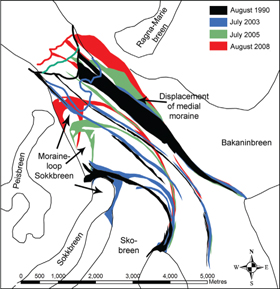
Fig. 3
Development of the surge illustrated by the progressive displacement of medial moraines and end moraine loops as well as the glacier-front positions. The illustration is based on the following images: NP1990 1:50.000 (black), Advanced Spaceborne Thermal Emission (ASTER) 24 July 2003 (blue), ASTER 23 July 2005 (green) and ASTER 4 August 2008 (red).
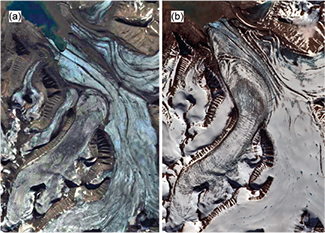
Fig. 4
Two Advanced Spaceborne Thermal Emission (ASTER) images showing Skobreen and most of Paulabreen showing the change in the crevasse pattern: (a) the early surge phase, 24 July 2003; (b) the full surge stage, 23 July 2005.
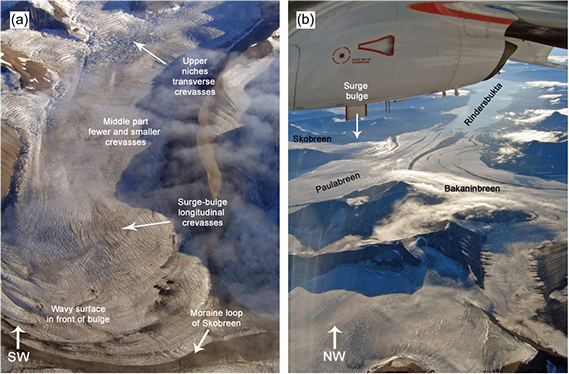
Fig. 5
Two oblique photographs on 8 August 2003, during the early surge stage: (a) most of Skobreen; (b) a major part of the catchment. Both photographs clearly show a surge bulge at the lower end of Skobreen. Photographer: Tavi Murray.
Between summer 2003 and spring 2005, the surge propagated downglacier and had affected most of the lower tongue of Paulabreen. On 2 April 2005, we observed that the south-west side of the glacier was heavily crevassed and brecciated. Sea ice was bulldozed in front of the glacier (Fig. 6) and continuous cracking noises indicated high activity. However, the north-east part of the glacier front was undisturbed, which suggests that we arrived soon after the surge front reached the glacier terminus. Fig. 7 shows the boundary between surging and non-surging ice in mid-April 2005.
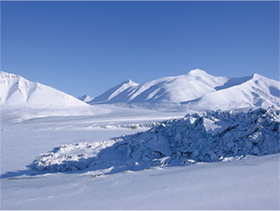
Fig. 6
The surging glacier advances into the fjord Rindersbukta, deforming the sea ice, in this photograph taken on 2 April 2005. Notice the chaotic brecciated glacier ice. Photographer: Anne-Marie LeBlanc.

Fig. 7
The front of Paulabreen–Bakaninbreen on 14 April 2005. In the spring of 2005, the surge had only reached the south-western half of the front.
By 23 July 2005, the surge had affected all of Skobreen and the entire width of Paulabreen (Fig. 4b). The moraine loop of Sokkbreen had moved 1300 m downglacier. The medial moraine between Paulabreen and Bakaninbreen was pushed obliquely downglacier, and its lower part had been displaced several hundreds of metres to the right (Fig. 3). The front had advanced by up to 1400 m. The length of the combined moraine-loop of Skobreen–Paulabreen increased from 3770 m (2003) to 5460 m (2005), probably indicating both shearing and extension of the ice along this line.
The time-lapse movie shows that the surge ended in the dark season of 2005–06, but the next cloud-free ASTER image is from 4 August 2008. Moraine loops and other debris features on the surface were located 1300 to 1500 m downstream and ca. 200 m laterally compared with 23 July 2005. The Skobreen–Paulabreen loop became 700 m longer (to 6155 m), signifying further extension along its line. The front had advanced between 200 and 400 m, although this must be less than the total ice displacement because some calving occurred after stagnation of the front. The average velocity in the main trunk during the entire surge was 3.2 m/day assuming an onset of the surge of Paulabreen of 24 July 2003 and a termination in December 2005. It is important to note that the surge front (the boundary between surging and non-surging ice) must have travelled downglacier considerably faster than this, as has been observed at other surging glaciers (e.g., Raymond et al. 1987; Murray et al. 2000; Frappe & Clarke 2007).
Oblique aerial photographs taken in September 2005 show the morphological effects of the surge on the glacier (Fig. 8). By that time, a large volume of ice had been transported from upper Skobreen (the reservoir area) into a lower receiving area. Remnants of ice left stranded on the walls of the Skobreen cirque after the surge show drawdown of at least 50 m over large areas. Almost the entire catchment of Skobreen was active in the surge, with the exception of a series of small niches around the cirque headwalls. Even in these areas, however, transverse crevassing indicates ice drawdown in response to lowering of the main glacier (Fig. 9). In the receiving area, the zone of most intense crevassing was around the margins of the surging part of the glacier, whereas a large part of Paulabreen behind the surge front was relatively uncrevassed. This suggests that much of the glacier was moving by plug flow over a weak substrate, consistent with the flow pattern shown in the time-lapse movie. Much of the stress exerted by this part of the glacier appears to have been supported around the margins, resulting in intense compression and fracturing.
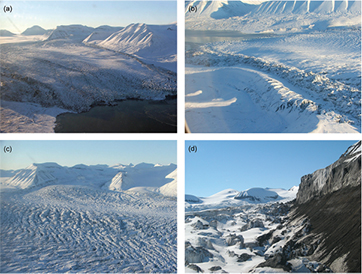
Fig. 8
Skobreen–Paulabreen during and following the surge. (a) The lower part of Paulabreen, viewed towards the south on 26 September 2005. Skobreen occupies the cirque in the upper middle part of the photograph, and the boundary between surging and non-surging ice on Paulabreen is visible on the upper left. (b) The surge front at the south-west margin of Paulabreen, 26 September 2005. Note the chaotically crevassed ice near the glacier front, behind which the ice is relatively uncrevassed. In the foreground of the photograph is a crevassed forebulge formed of old, buried glacier ice. (c) View over Paulabreen into Skobreen, 26 September 2005. (d) Remnant ice stranded above Skobreen after surge termination, 18 June 2007. The ice cliff is ca. 50 m high.
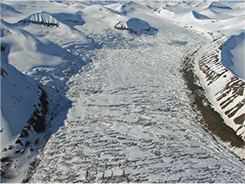
Fig. 9
Photograph taken on 18 June 2007 towards the south-west showing most of Skobreen after the surge. The majority of the glacier is covered with transverse crevasses, including the niches to the left in the picture. Note the substantial down-draw on either side of the main trunk. Towards the bottom in the picture longitudinal crevasses can be seen.
Summary and conclusions
During 2003 and 2005 Skobreen and the lower part of Paulabreen, Svalbard, experienced a major surge. ASTER images from different stages of the surge together with an aerial photograph before the onset of the surge were used to evaluate the surge progression. The surge initiated in Skobreen, and propagated downglacier into Paulabreen eventually resulting in an advance of the glacier into the fjord. The medial moraines of Paulabreen were progressively displaced obliquely downglacier, with a lateral displacement of several hundreds of metres. Ice was displaced a maximum of 2800 m downstream, measured from displacement of debris surface features, giving an average ice velocity of 3.2 m/day. The front advanced less than the total ice displacement (1300–1800 m), as calving occurred during the surge. The evidence for plug flow suggests that the high velocities were the result of basal motion (sliding and/or till deformation) facilitated by pressurized water at the bed.
A time-lapse movie (see Supplementary File) captured the advance of the frontal part of the glacier, and dramatically illustrates glacier dynamic processes in an accessible way. The movie documents a range of processes such as a plug like flow of the glacier, proglacial thrusting, incorporation of old, dead ice at the margin and calving into the fjord. In our experience, the movie provides a powerful resource for teaching and inspiring students, and for communicating the fascination of glacier science to a wider public.
Acknowledgements
We kindly acknowledge the following people and institutions: Svalbard Villmarkssenter, a local tour company that drew our attention to the surge of Paulabreen. Store Norske Spitsbergen Kulkompani who funded the camera and provided logistical support. The University Centre in Svalbard (UNIS) provided funding and logistical support, and Lars Grande helped secure funding for the camera system. Anne-Marie LeBlanc, Alex Wolfe, Ole Humlum, Ruth Mottram, Lars Grande, Fabrice Caline and various student groups at UNIS helped in the field. The photographs in Fig. 5 were kindly provided by Tavi Murray. The ASTER images were obtained from the Land Processes Distributed Active Archive Centre of the US National Aeronautics and Space Administration. The 1990 aerial photograph (Fig. 3) is used with permission from the Norwegian Polar Institute.
References
Benn
D.I.,
Kristensen
L.
&
Gulley
J. 2009.
Surge propagation constrained by a persistent subglacial conduit, Bakaninbreen–Paulabreen, Svalbard. Annals of Glaciology 50,
81–86.
[Crossref]
Cöster
F. 1925.
Results of the Swedish expedition to Spitsbergen in 1924. 1: Quaternary geology of the region around the Kjellström valley. Geografiska Annaler 7,
104–120.
[Crossref]
De Geer
G. 1919.
Om Spetsbergens natur i Sveagruvans omnejd. (The natural environment of Spitsbergen in the area of Sveagruva.) Ymer 39,
238–277.
Dowdeswell
J.A.,
Hamilton
G.S.
&
Hagen
J.O. 1991.
The duration of the active phase on surge-type glaciers: contrasts between Svalbard and other regions. Journal of Glaciology 37,
388–400.
Dowdeswell
J.A.,
Hodgkins
R.,
Nuttall
A.M.,
Hagen
J.O.
&
Hamilton
G.S. 1995.
Mass-balance change as a control on the frequency and occurrence of glacier surges in Svalbard, Norwegian High Arctic. Geophysical Research Letters 22,
2909–2912.
[Crossref]
Eisen
O.,
Harrison
W.D.
&
Raymond
C.F. 2001.
The surges of Variegated Glacier, Alaska, USA, and their connection to climate and mass balance. Journal of Glaciology 47,
351–358.
[Crossref]
Evans
D.J.A.
&
Rea
B.R.
2003.
Surging glacier land system.
In D.J.A. Evans (ed.): Glacial land systems. Pp. 259–288. London: Hodder Arnold.
Fowler
A.C.,
Murray
T.
&
Ng
F.S.L. 2001.
Thermally controlled glacier surging. Journal of Glaciology 47,
527–538.
[Crossref]
Frappe
T.P.
&
Clarke
G.K.C.
2007. Slow surge of Trapridge Glacier, Yukon Territory, Canada. Journal of Geophysical Research—Earth Surface 112, F03S32, doi: 10.1029/2006JF000607.
[Crossref]
Hagen
J.O.,
Liestol
O.,
Roland
E.
&
Jørgensen
T.
1993. Glacier atlas of Svalbard and Jan Mayen. Oslo: Norwegian Polar Institute.
Hald
M.,
Dahlgren
T.,
Olsen
T.-E.
&
Lebesbye
E. 2001.
Late Holocene palaeoceanography in Van Mijenfjorden, Svalbard. Polar Research 20,
23–35.
[Crossref]
Hamilton
G.S.
&
Dowdeswell
J.A. 1996.
Controls on glacier surging in Svalbard. Journal of Glaciology 42,
157–168.
Harrison
W.D.
&
Post
A.S. 2003.
How much do we really know about glacier surging? Annals of Glaciology 36,
1–6.
[Crossref]
Hewitt
K. 2007.
Tributary glacier surges: an exceptional concentration at Panmah Glacier, Karakoram Himalaya. Journal of Glaciology 53,
181–188.
[Crossref]
Jiskoot
H.,
Boyle
P.
&
Murray
T. 1998.
The incidence of glacier surging in Svalbard: evidence from multivariate statistics. Computers & Geosciences 24,
387–399.
[Crossref]
Jiskoot
H.,
Murray
T.
&
Boyle
P. 2000.
Controls on the distribution of surge-type glaciers in Svalbard. Journal of Glaciology 46,
412–422.
[Crossref]
Kamb
B.,
Raymond
C.F.,
Harrison
W.D.,
Engelhardt
H.,
Echelmeyer
K.A.,
Humphrey
N.,
Brugman
M.M.
&
Pfeffer
T. 1985.
Glacier surge mechanism: 1982–1983 surge of Variegated Glacier, Alaska. Science 227,
469–479.
[Crossref]
Kjellström
O.C.J. 1901.
En exkursion för uppmätning af Van Mijen bay under 1898 års svenska polarexpedition. (An excursion to survey Van Mijen Bay during the 1898 Swedish polar expedition.) Ymer 1,
29–34.
Kristensen
L.,
Benn
D.I.,
Hormes
A.
&
Ottesen
D. 2009.
Mud aprons in front of Svalbard surge moraines: evidence of subglacial deforming layers or proglacial tectonics? Geomorphology 111,
206–221.
[Crossref]
Meier
M.F.
&
Post
A. 1969.
What are glacier surges? Canadian Journal of Earth Sciences 6,
807–817.
[Crossref]
Murray
T.,
Dowdeswell
J.A.,
Drewry
D.J.
&
Frearson
I. 1998.
Geometric evolution and ice dynamics during a surge of Bakaninbreen, Svalbard. Journal of Glaciology 44,
263–272.
Murray
T.
&
Porter
P.R. 2001.
Basal conditions beneath a soft-bedded polythermal surge-type glacier: Bakaninbreen, Svalbard. Quaternary International 86,
103–116.
[Crossref]
Murray
T.,
Strozzi
T.,
Luckman
A.,
Jiskoot
H.
&
Christakos
P.
2003. Is there a single surge mechanism? Contrasts in dynamics between glacier surges in Svalbard and other regions. Journal of Geophysical Research—Solid Earth
108, article no. 2237, doi: 10.1029/2002JB001906.
[Crossref]
Murray
T.,
Stuart
G.W.,
Miller
P.J.,
Woodward
J.,
Smith
A.M.,
Porter
P.R.
&
Jiskoot
H. 2000.
Glacier surge propagation by thermal evolution at the bed. Journal of Geophysical Research—Solid Earth 105,
13491–13507.
[Crossref]
Nick
F.M.,
van der Veen
C.J.,
Vieli
A.
&
Benn
D.I. 2010.
A physically based calving model applied to marine outlet glaciers and implications for their dynamics. Journal of Glaciology 56,
781–794.
[Crossref]
Nolan
M. 2003.
The “Galloping Glacier” trots: decadal-scale speed oscillations within the quiescent phase. Annals of Glaciology 36,
7–13.
[Crossref]
Nuth
C.,
Kohler
J.,
Aas
H.F.,
Brandt
O.
&
Hagen
J.O. 2007.
Glacier geometry and elevation changes on Svalbard (1936–90): a baseline dataset. Annals of Glaciology 46,
106–116.
[Crossref]
Ottesen
D.,
Dowdeswell
J.A.,
Benn
D.I.,
Kristensen
L.,
Christiansen
H.H.,
Christensen
O.,
Hansen
L.,
Lebesbye
E.,
Forwick
M.
&
Vorren
T.O. 2008.
Submarine landforms characteristic of glacier surges in two Spitsbergen fjords. Quaternary Science Reviews 27,
1583–1599.
[Crossref]
Porter
P.R.,
Murray
T.
&
Dowdeswell
J.A. 1997.
Sediment deformation and basal dynamics beneath a glacier surge front: Bakaninbreen, Svalbard. Annals of Glaciology 24,
21–26.
Punning
J.-M.,
Troitsky
L.
&
Rajamäe
R. 1976.
The genesis and age of the Quaternary deposits in the eastern part of Van Mijenfjorden, west Spitsbergen. Geologiska Föreningens i Stockholm Förhandlingar 98,
343–347.
[Crossref]
Raymond
C.F.,
Johannesson
T.,
Pfeffer
T.
&
Sharp
M. 1987.
Propagation of a glacier surge into stagnant ice. Journal of Geophysical Research 92,
9037–9049.
[Crossref]
Rowan
D.E.,
Pewe
T.L.
&
Pewe
R.H. 1982.
Holocene glacial geology of the Svea Lowland, Spitsbergen, Svalbard. Geografiska Annaler 64A,
35–51.
[Crossref]
Sund
M. 2006.
A surge of Skobreen, Svalbard. Polar Research 25,
115–122.
[Crossref]
Sund
M.,
Eiken
T.,
Hagen
J.O.
&
Kaab
A. 2009.
Svalbard surge dynamics derived from geometric changes. Annals of Glaciology 50,
50–60.
[Crossref]
Vieli
A.,
Jania
J.
&
Kolondra
L. 2002.
The retreat of a tidewater glacier: observations and model calculations on Hansbreen, Spitsbergen. Journal of Glaciology 48,
592–600.
[Crossref]
Waddington
E.D. 1986.
Wave ogives. Journal of Glaciology 32,
325–334.